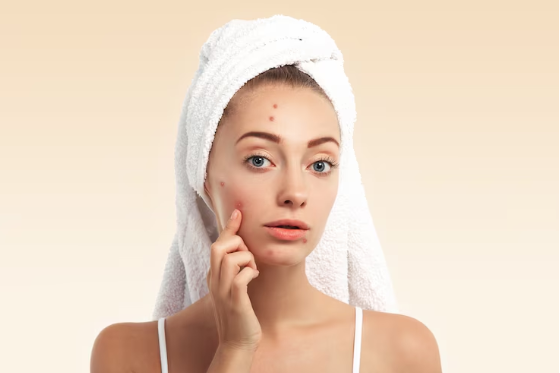Acne is a common skin condition that affects millions of people worldwide. While it can be frustrating to deal with, the good news is that there are numerous acne spot treatment options available to help you combat those pesky pimples and achieve clearer skin.
In this comprehensive guide, we’ll explore the most effective acne spot treatments, how they work, and tips for choosing the right one for your skin type.
Additionally, it’s always beneficial to consult with skincare experts or dermatologists to get personalized recommendations tailored to your specific skin concerns and needs. For more expert advice and high-quality skincare products, visit MOYEM today.
Understanding Acne: Causes and Types
Before diving into acne spot treatments, it’s essential to understand what causes acne and the different types of acne you might encounter.
What Causes Acne?
Acne occurs when hair follicles become clogged with oil and dead skin cells. Several factors can contribute to this, including:
- Hormonal Changes: Fluctuations in hormone levels, particularly during puberty, menstruation, or pregnancy, can lead to increased oil production.
- Genetics: If your parents had acne, you’re more likely to develop it as well.
- Diet: Consuming high-glycemic foods and dairy products may exacerbate acne for some people.
- Stress: Chronic stress can trigger hormonal changes that contribute to acne flare-ups.
- Skin Care Products: Using comedogenic or pore-clogging products can worsen acne.
Types of Acne
There are several types of acne, each with its own characteristics and treatment options:
- Whiteheads: Closed comedones that appear as small, white bumps on the skin.
- Blackheads: Open comedones that are dark in color due to oxidation of the trapped sebum.
- Papules: Small, red bumps that are tender to the touch.
- Pustules: Red bumps with pus at the top.
- Nodules: Large, painful bumps deep within the skin.
- Cysts: Painful, pus-filled lumps beneath the skin’s surface.
Top Acne Spot Treatment Ingredients
When it comes to treating acne, there are several key ingredients that have been proven to be effective. Here’s a rundown of the most commonly used and recommended acne spot treatment ingredients:
Salicylic Acid
Salicylic acid is a beta hydroxy acid (BHA) that works by exfoliating the skin and unclogging pores. It’s particularly effective for treating whiteheads and blackheads.
How it works: Salicylic acid dissolves the keratin plugs that block pores, allowing for the removal of dead skin cells and excess oil.
Benzoyl Peroxide
Benzoyl peroxide is an antimicrobial agent that kills acne-causing bacteria and reduces inflammation.
How it works: Benzoyl peroxide releases oxygen into the pores, which helps to kill bacteria and reduce the production of excess oil.
Retinoids
Retinoids, such as tretinoin and adapalene, are vitamin A derivatives that promote cell turnover and unclog pores.
How it works: Retinoids increase cell turnover, prevent the formation of new comedones, and reduce inflammation.
Sulfur
Sulfur is a natural mineral that has antimicrobial and anti-inflammatory properties.
How it works: Sulfur helps to unclog pores, reduce oil production, and kill acne-causing bacteria.
Choosing the Right Acne Spot Treatment
With so many acne spot treatment options available, it can be overwhelming to choose the right one for your skin. Here are some tips to help you make an informed decision:
Consider Your Skin Type
Different acne spot treatments are formulated for specific skin types, so it’s important to consider whether you have oily, dry, sensitive, or combination skin.
Start with a Lower Strength
If you’re new to acne spot treatments or have sensitive skin, it’s best to start with a lower strength product to minimize the risk of irritation.
Read Reviews and Do Your Research
Before purchasing an acne spot treatment, read reviews and research the ingredients to ensure they are effective and suitable for your skin type.
Patch Test
Before applying any new acne spot treatment to your face, perform a patch test on a small area of skin to check for any adverse reactions.
How to Use Acne Spot Treatments Effectively
Once you’ve chosen an acne spot treatment, it’s important to use it correctly to maximize its effectiveness and minimize irritation.
Cleanse Your Skin
Start by cleansing your skin with a gentle, non-comedogenic cleanser to remove dirt, oil, and makeup.
Apply a Thin Layer
Apply a thin layer of the acne spot treatment to the affected areas using clean fingertips or a cotton swab.
Follow Up with Moisturizer
After the acne spot treatment has dried, apply a moisturizer to hydrate and soothe the skin.
Use as Directed
Follow the manufacturer’s instructions for how often to apply the acne spot treatment and how long to leave it on the skin.
Natural Acne Spot Treatments
If you prefer natural alternatives to conventional acne spot treatments, there are several options you can try:
Tea Tree Oil
Tea tree oil has antimicrobial and anti-inflammatory properties that can help reduce acne lesions.
How to use: Dilute tea tree oil with a carrier oil, such as jojoba or coconut oil, and apply to the affected areas using a cotton swab.
Aloe Vera
Aloe vera has soothing and anti-inflammatory properties that can help reduce redness and inflammation associated with acne.
How to use: Apply a thin layer of pure aloe vera gel to the affected areas and leave on overnight.
Green Tea Extract
Green tea extract contains antioxidants and anti-inflammatory compounds that can help reduce acne lesions and calm the skin.
How to use: Brew a cup of green tea, allow it to cool, and apply to the affected areas using a cotton ball or spray bottle.
Conclusion
Dealing with acne can be frustrating, but with the right acne spot treatment, you can effectively combat pimples and achieve clearer, healthier-looking skin. Whether you prefer over-the-counter products or natural remedies, there are numerous options available to help you on your journey to acne-free skin.
Remember to choose a treatment that is suitable for your skin type, follow the manufacturer’s instructions, and be patient – clear skin takes time and consistent care.
See Also: Überstezet: The Ultimate Translation Tool
